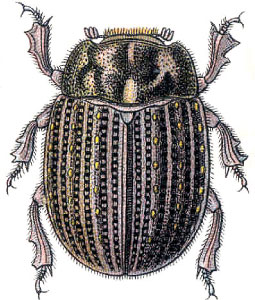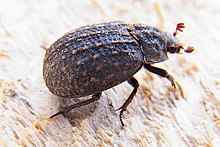Earth beetle
| Earth beetle | ||||||||||||
|---|---|---|---|---|---|---|---|---|---|---|---|---|

Illustration by Trox sabulosus from Reitters Die Käfer des Deutschen Reiches |
||||||||||||
| Systematics | ||||||||||||
|
||||||||||||
| Scientific name | ||||||||||||
| Trogidae | ||||||||||||
| Macleay , 1819 |

The earth beetles (Trogidae) are a family of beetles within the superfamily Scarabaeoidea . The worldwide distributed family consists of three genera and about 300 species. In Europe, 23 species from two genera have been identified. In Central Europe only the genus Trox is represented with seven species. The African fauna includes about 70 species of the family, about half each from the genera Trox and Omorgus , in South America the latter genus represents about two thirds of the species, the rest falls to the genus Polynoncus . In Australia, 51 species of the genus Omorgus and the introduced Trox scaber have been recorded, in North America 16 species of the genus Omorgus and 25 species of the genus Trox are native.
features
Beetle
The beetles are 5 to 25 millimeters long. They have an elongated oval, convex body. This is brown or gray to black in color and often covered with gray, yellow or brown hairs. dorsally , the animals are often dirty. The frontoclypeal suture is clear in the genus Omorgus , but difficult to see in Trox . The compound eyes do not have a canthus (a protrusion of the head capsule that protrudes into the eye contour and divides the eye partially, or even completely, into an upper and a lower section). The structure of the ommatidia is different. The epipharynx is symmetrical or asymmetrical and has lateral tormas (a pair of small, mostly dark-colored sclerites on the side of the lower lip). The antennae are ten-part and have a three-part club. The mandibles have a well-developed brush and prostheca (a movable, finger-shaped process). The maxillary palps are four-membered. The mentum and prementum of the lower lip are usually fused together. The indentations of the hips ( coxes ) of the middle legs are closed. An empodium (adhesive flap on the feet to attach to smooth surfaces) is missing. The subalare Tendon the wing vein 2Ax is short, narrow, rounded at the tip, 2BP has missing oblique waves on the Media handlers, mesial and distal from the medial bridge of 2BP and RP34. There are five visible ventrites (visible abdominal sclerites ) on the abdomen. The stigmas on the abdomen lying in the pleural membranes have a double opening in Trox , in the other genera they are sieve-shaped (cribriform). With Trox , the first to the seventh are functional, with Omorgus the eighth is also functional. The aedeagus is heavily sclerotized and consists of a clearly symmetrical triple lobe. In the females, the tergites , pleurites and sternites of the ninth abdominal segment can be seen as clearly sclerotized areas. Hemisternites with styli are available.
Larvae
The body of the larvae is broadly C-shaped. Their heads are almost black. The segments of the thorax and the first six abdominal segments are divided dorsally into three folds. The cranium is symmetrical. At least one point eye ( ocellus ) is always developed. The antennae are tripartite and do not have a large sensory mark. The mandibles are asymmetrical, have an anterior process and anteriorly no area to stridulate . Galea and Lacinia are clearly separated from each other. The thigh rings ( trochanters ) of the middle legs and the hind legs lack an organ for generating sound . As with adults, the stigmas are either sieve-shaped or have a double opening.
Way of life
The earth beetles are unique within the superfamily Scarabaeoidea in that both the larvae and the adults of all species mainly feed on keratin . The animals are among the last insects to visit cadavers. But they also feed on old pelts, feathers and various other animal remains. Earth beetles have also been detected eating bat guano in caves or hollow trees. Unlike the larvae, the adults can produce audible noises through stridulation . The females usually lay their eggs under carcasses. The larvae transport pieces of skin and hair into their tunnels that reach vertically below the carcass.
Taxonomy and systematics
The relationship of the most primitive families within the superfamily Scarabaeoidea has been interpreted differently in the course of research history and has not yet been fully clarified. Crowson placed them in the superfamily Scarabaeoidea. Howden suspected in a paper from 1982 a relationship to the Hybosoridae . Based on wing characteristics, a relationship between the Glaphyridae and Bolboceratidae + Pleocomidae was later assumed. The family could be a sister group of the passalid subgroup of the superfamily.
The earth beetle family is a well-established group that possesses numerous derived traits. The following autapomorphies support the monophyly : In the imagines, the attachment of the subalar tendon of the wing vein 2Ax is short, narrow and apically rounded, 2BP has oblique waves on the medial artery, mesial from the medial bridge and distal from 2BP and RP34. In addition, the diet of keratin is characteristic. In the larvae, the long bristles on the body are spiral-shaped, the cranium and tergum of the prothorax are significantly darker than the rest of the body and almost black, the galea has membranous subdivisions and the basal part of the labial palps has bristle-like structures dorsally. In addition, the way of life on cadavers is typical.
The following list includes all genera, as well as the European species:
- Genus Trox (Holakrits, Afrotropis)
- Trox cadaverinus Illiger, 1801
- Trox cotodognanensis Compte, 1986
- Trox cribrum Gené, 1836
- Trox cricetulus Ádám, 1994
- Trox eversmanni Krynicky, 1832
- Trox fabricii Reiche, 1853
- Trox granulipennis Fairmaire, 1852
- Trox hispidus Pontoppidan, 1763
- Trox klapperichi Pittino, 1983
- Trox leonardii Pittino, 1983
- Trox litoralis Pittino, 1991
- Trox martini Reitter, 1892
- Trox morticinii Pallas, 1781
- Trox niger Rossi, 1792
- Trox nodulosus Harold, 1872
- Trox perlatus Goeze, 1777
- Trox perrisii Fairmaire, 1868
- Trox sabulosus (Linnaeus, 1758)
- Trox scaber (Linnaeus, 1767)
- Trox sordidatus Balthasar, 1936
- Trox transversus Reiche, 1856
- Genus Omorgus (continents of the former Gondwana and southern North America)
- Omorgus subcarinatus (MacLeay, 1864)
- Omorgus suberosus (Fabricius, 1775)
- Genus Polynoncus (Neotropis)
supporting documents
Individual evidence
- ↑ a b c d e f g h Rolf G. Beutel, Richard AB Leschen: Handbuch der Zoologie - Coleoptera, Beetles, Volume 1: Morphology and Systematics (Archostemata, Adephaga, Myxophaga, Polyphaga partim) . 1st edition. de Gruyter , 2005, ISBN 3-11-017130-9 , p. 371 f . (English).
- ↑ a b Trogidae. Fauna Europaea, accessed August 20, 2012 .
- ^ Karl Wilhelm Harde , František Severa : Der Kosmos-Käferführer. The Central European beetle . Franckh-Kosmos, Stuttgart 2000, ISBN 3-440-06959-1 , p. 246 f .
literature
- Rolf G. Beutel, Richard AB Leschen: Handbuch der Zoologie - Coleoptera, Beetles, Volume 1: Morphology and Systematics (Archostemata, Adephaga, Myxophaga, Polyphaga partim) . 1st edition. de Gruyter , 2005, ISBN 3-11-017130-9 (English).
